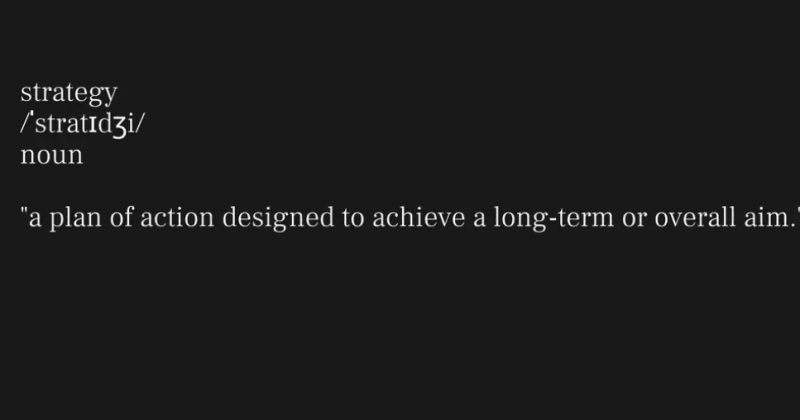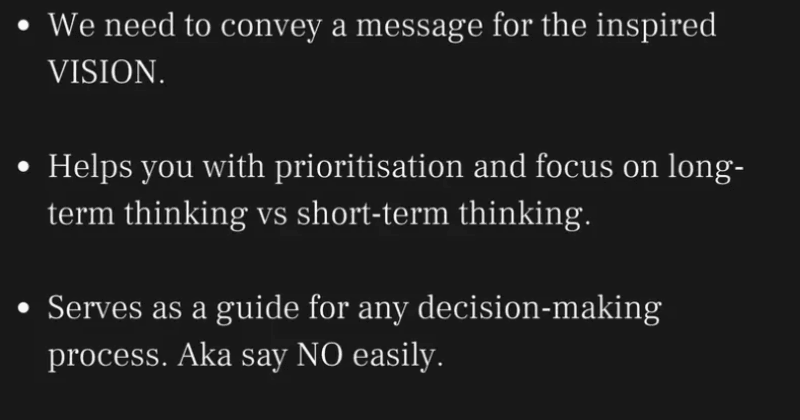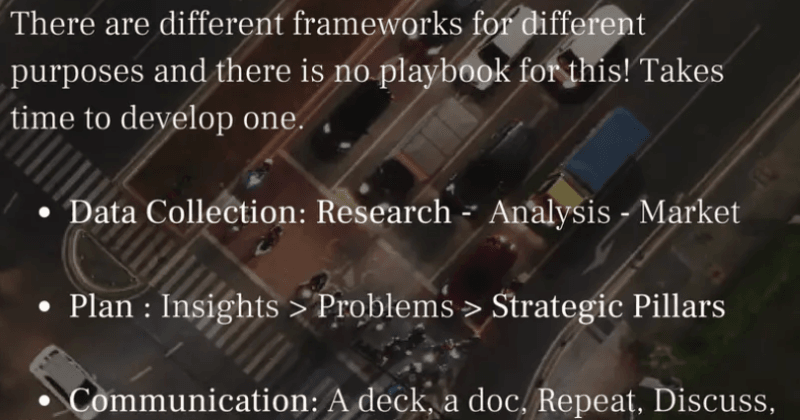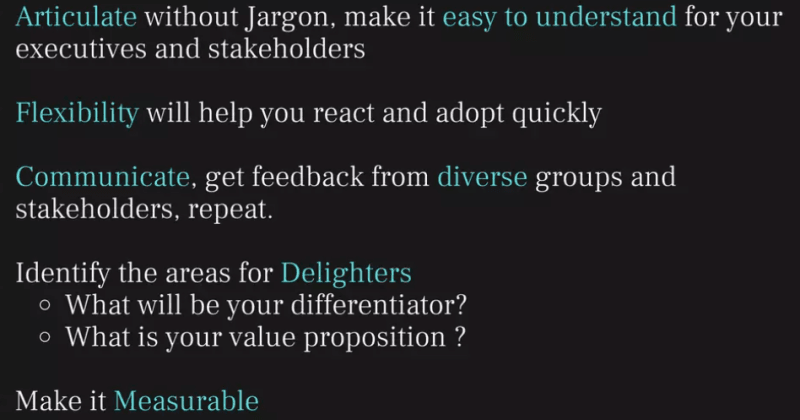Updated: July 1, 2024- 9 min read
Let's face it - as a product leader, you’re constantly faced with challenges. With a myriad of problems vying for your attention, it's imperative to anchor yourself with a clear product vision and an effective product strategy. While most of us have theoretical know-how embedded in our arsenal, integrating this knowledge into our daily workflows can be a hurdle. Sound familiar?
Editorial note: This post is based on a talk by Buket Baran, Spotify Sr PM, on Powerful Product Vision & Effective Strategy and contains additional insights and examples from the Product School team. You can watch the webinar in full above.
Unpacking the world of product strategy
When strategies aren't clearly communicated, especially in tech companies, it's like trying to navigate without clear directions. Different teams can end up following their own interpretations, leading to confusion and overlapping product goals. This muddles the roadmap and weakens the ability to prioritize correctly. The consequence? A lack of clarity in decision-making and the reduced ability to reject unnecessary ideas.
But why is saying 'no' so instrumental? In product management, while there’s a universe teeming with brilliant ideas, there's often that singular golden concept that aligns perfectly with your target user's needs. Echoing the words of Steve Jobs, true innovation lies not in chasing every opportunity, but in discerningly saying no to a thousand others.
So, how do we wield this power of discernment? The answer lies rooted in strategy.
Defining product strategy
Before we delve deeper, let's distill the essence of 'strategy'. At its core, a strategy is a meticulously crafted blueprint aimed at realizing a long-term vision or goal. Think of it as your trusted map, charting out the path to your destination.

Imagine you're planning a cross-country drive. You plot your route, estimate fuel needs, and even pre-plan a few pit stops. Sounds straightforward, right? But, as with most journeys, sometimes there are unforeseen hiccups—a sudden detour, unexpected weather, or maybe a flat tire.
Just as you'd adjust your route or strategy during a road trip, as a product manager, you have to be ready to pivot when unforeseen challenges arise. This flexible, yet goal-oriented approach is the essence of an effective product strategy. It's about foreseeing possible scenarios and planning for them, but also being adaptable enough to change course when the situation demands. Your product's success lies in navigating these challenges and making informed decisions every step of the way.
Why is product strategy important?
Take a moment to reflect: Why do products succeed? And more importantly, why do they fail? A significant determinant of a product's fate lies in its strategy. So, why exactly do we need an effective product strategy? Let's dive in.

1. An effective product strategy breathes life into your vision
Having a vision is vital. But, to make this vision actionable and inspiring, a strategy is your best ally. A mere vision statement, though essential, can't do the heavy lifting alone. It needs the support of a strategy to be its voice, to instill trust, to inspire minds, and sometimes, to win hearts. In short, your product strategy amplifies your vision, ensuring it resonates through every corner of your organization.
2. Strategy enhances focus and nurtures long-term view
In product management, it's easy to get lost in a whirlwind of tasks. A clear strategy acts as your compass, ensuring you prioritize what truly matters. It nudges you to invest your time and resources in areas promising long-term value, fostering a culture of strategic thinking. After all, with limited resources, placing bets on the right tasks is crucial.
3. Strategy empowers decision-making and the art of saying 'No'
Here's a reality you're all too familiar with: as a Product Manager, saying 'no' is often harder than saying 'yes'. But with an effective product strategy in place, the process becomes clearer. When confronted with requests that deviate from your core strategy, the answer becomes evident. It serves as a barrier against distractions, helping you stay focused on your product's core mission.
4. Streamlined communication and improved alignment
Ever felt like your team wasn’t aligned? A strategy ensures everyone is on the same page. Without it, each team member might follow their own path, leading to confusion. A solid product strategy provides clear goals and direction. As a Product Manager, your role is to guide everyone using this roadmap, making sure all stakeholders, from top leadership to team members, are working harmoniously towards a common goal. Essentially, it's what keeps everyone united.
Crafting your product strategy
Understanding the importance of a strategy is only half the battle. Now, it's time to roll up your sleeves and dive into creating one. While several frameworks exist, tailored to various purposes, our focus today is on the foundational elements - the cornerstones of every strategy. To make it manageable, we'll break down the creation process into three pivotal steps.

Step 1: Dive deep into research and data collection
Every strategic journey begins with a single step: understanding the 'why'. This means diving deep into customer pain points. Remember, a jack-of-all-trades approach doesn't cut it in the world of product management. You must zero in on what is invaluable to your target audience and aligns with company objectives.
The heart of every strategic decision lies in customer-centricity. This doesn't only pertain to external users but can also involve internal customers, like teams using your platform. Determining what resonates with these audiences will dictate the course of your strategy. Yet, gut instincts aren't enough. You must validate these pain points with concrete data, be it quantitative or qualitative. Collaborate with UX researchers, insights teams, or delve into data yourself. Understand market gaps, competition, and environmental factors. Only then you will have a comprehensive picture to move forward.
Step 2: Plan
Once you're armed with insights, it's time for the planning phase. What's crucial here is understanding what you're truly aiming for. Align your strategy with broader company goals and pinpoint your North Star metric to start gauging this strategy's effectiveness.
Remember, while a vision remains relatively static, strategies are fluid. They evolve. Get started with a framework, test it out, refine it, or pivot as needed. Identify and group your challenges into strategic pillars, giving you a structured roadmap for action.
Pro tip: Strategy is dynamic. While visions rarely waver, the route you take to achieve them might need tweaking or a complete overhaul.
Step 3: Spread the word
So, you've identified the problems, and set up your strategic pillars - what's next? Well, a strategy that remains confined to a document or your mind is futile. It needs to be vocalized, shared, and iterated upon.
Regularly discuss your strategy with your team, stakeholders, and leadership. This not only validates your perspective but also brings to light any facets you might have overlooked. If you're working on cross-functional projects, communication becomes paramount to secure buy-ins from various teams.
Tailor your communication style based on your audience - a deck for visual learners, and comprehensive documents for those who prefer depth. But regardless of the medium, feedback is gold. Address it, if possible, or explain why it can't be implemented. By being transparent, you foster trust and buy-in.
Make an effective product strategy
So, you've laid out your strategy, but things aren't unfolding as expected. Perhaps you're encountering the same challenges, or the impact isn't as profound as you'd hoped. This suggests your strategy might be falling short. But how can you create an effective product strategy? Here are six tips to take your strategy from good to great.

1. Zoom in on needs and pain points
A stellar strategy always zeroes in on the genuine pain points of your target customers. Realize that you can't cater to everyone's tastes with limited resources. To streamline your focus, align your strategy with overarching business objectives. Are you looking to monetize, boost engagement, or onboard new users? Cross-reference these goals with identified problems.
Consider how Spotify expertly crafted its strategy. While charting their course, they seamlessly intertwined current problem areas with prospective focal points, giving them a crystal-clear vision of their next areas of emphasis. This method not only illuminated their immediate challenges but also shed light on future opportunities.
2. Clarity is king
For a strategy to succeed, it must be crystal clear. Whether it's the C-suite or frontline employees, your strategic vision should resonate with everyone. Steer clear of industry jargon. Clarity paves the way for advocacy. If they don't grasp it, they can't champion it.
Reflect on Amazon's PR FAQ documents: simplicity is at their core, free from business or tech jargon. By framing your strategy from a customer's vantage point, you'll further streamline comprehension.
3. Embrace flexibility
Aim high with broad objectives, letting your North Star guide you through present challenges toward future aspirations. However, the journey might need recalibration.
Foster a culture of innovation and routinely assess your strategy's progression. Lay down protocols for adapting to unforeseen changes or obstacles. Which strategy segments are set in stone? Who holds the reins for potential pivots? Deciphering these queries in advance will bolster clarity during execution. Commit to a learning loop, drawing lessons from missteps and iterating for enhanced results.
4. Communicate, Iterate, Repeat
Even the most seasoned product managers can sometimes lose touch with the pulse of their customers. Engage with your audience, gather diverse perspectives, and refine your strategy based on this invaluable feedback.
5. Pinpoint the 'Delighters'
The Kano Model underscores the significance of 'delighters' in product offerings. Beyond basic and performance features, 'delighters' are those unexpected perks that charm users. They might not be essential, but they amplify user satisfaction immeasurably. They're the secret sauce, granting your product an edge over competitors.
But, ensure your 'delighter' truly resolves a concern or seizes an opportunity. It should be more than just a 'nice-to-have'—it should carve a distinct niche for your product. Devote resources to making sure users perceive their inherent value.
6. Make it measurable
Lastly, ensure your strategy isn't just a vision—it should be tangible and quantifiable. Associate strategic pillars with measurable goals. This aids in tracking progress, validating hypotheses, and making requisite adjustments.
Learn more with Product School
Master the art of effective strategizing and lead your Product teams to success with our Product Leader Certification (PLC)® designed by successful Product Managers to help you build end-to-end product development skills while offering the hands-on experience you need to lead product teams.
Discover the PLC today, and take the first step towards becoming a strategic, successful, and influential Product Manager. Schedule a call today to find out more.
Updated: July 1, 2024





